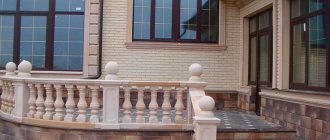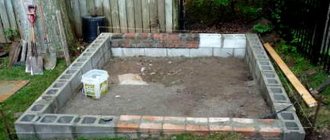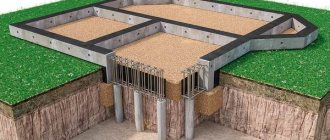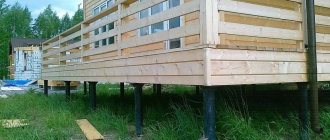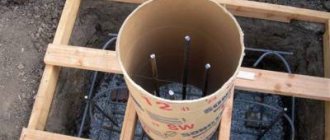When building a house, great importance is given to the construction of the foundation. We have said more than once that the foundation is the foundation of the future home. That's why it needs to be taken seriously. The soil and soil quality of the area where the house will be built is of key importance when choosing the type of foundation. Today we will look at the pros and cons of a pile foundation. The entire construction technology depends on the type of soil on the site, so before starting to build a house, we recommend that you definitely do geotechnical surveys. This will allow you to accurately determine the type of foundation for building your home.
In many regions of Russia, swampy, flooded or weak-bearing soils predominate. This makes the construction process problematic. This is especially true for the construction of private houses. But nevertheless, it is necessary to build somehow, and the use of a traditional strip or even slab foundation on such soils is simply unacceptable. In such cases, a pile foundation comes to the rescue. It is based on the installation of supporting structures. Such structures ensure good contact of the future house with dense layers of soil. And most importantly, they allow you to build very large and massive structures without fear for their stability. But is such a foundation good and safe? Are there any disadvantages of a pile foundation and what are they? Let's sort it out in order.
An example of a pile foundation for a house
Next, we will examine in detail the lighter version of the pile foundation. This includes screw piles. We'll tell you how to install screw piles so that they don't fail. And also what are the advantages of screw piles for the foundation of a house.
Foundation on screw piles
What are screw piles? What are their features and convenience? And how to make a foundation with their help? Screw piles are such a support structure. It is a system of pipes that are immersed in the ground to a certain depth. Spiral blades are welded at the bottom of these pipes (as in the photo). This design allows you to screw piles into the ground. And the blades play the role of cutting, with approximately the same effect as on screws. The sharp tip of the pile makes it easier for it to penetrate the ground. And the thread, in addition to being used for screwing, is also a support unit on which the pile actually rests.
How is the support supported and how reliable is it, you ask? We answer: such a pile is supported by the friction force that occurs between the soil and the side surfaces of the pile (pipe). This design is reinforced by the same blades that we have already talked about. They bear part of the load, which makes such a support very reliable, with proper installation, of course. By the way, the installation of such piles itself has a lot of subtleties that must be observed. Failure to comply with them may result in the pile being flimsy and unreliable. So, in order to evenly distribute the load on each pile, the installation is carried out according to a pre-calculated scheme. A so-called pile field is formed. It ensures an even load on each support.
Grillage
When the piles are already immersed, their upper parts are cut off in such a way that a flat plane is obtained. Then they make a grillage or otherwise call it a load-bearing belt. This is the main structure that distributes the load from the walls. And most importantly, thanks to it, the load on the pile system is distributed evenly, without overloading any of the piles, which gives this structure reliability and durability.
The structure and functions of the grillage are very similar to the design of a strip foundation. The difference in this design is that the grillage, instead of being supported on the ground, like a strip foundation, is supported on piles. In order for the structure to become rigid and less susceptible to lateral loads, the hollow tubes of the piles are filled with concrete after installation. This creates additional stability and rigidity of the structure.
Of course, there are both pros and cons of a pile foundation. But the clear advantage of screw piles is that when installing them, it is not necessary to immerse them until they come into contact with dense layers of soil, as with other piles. The peculiarity of their design allows them to reliably hold the building with sufficient penetration into the ground. Screw piles are a hanging type of piles.
Grillage arrangement
Description of strip foundations
They are massive building structures made of reinforced concrete, blocks, stone or brick. In terms of its external configuration, such a foundation is a continuous support for walls in the form of a flat strip. The use of a large number of materials makes the construction of a strip base a labor-intensive and expensive undertaking.
The entire weight load from the building’s building structures is transferred to the stone belt and evenly distributed onto the ground.
On stable, dense soils it can be used for any buildings up to 5 floors high. In case of weak soil, heaving and horizontal movements, the maximum height of the house is up to 2 floors.
Use on marshy and clayey soils is not recommended.
The installation of a strip foundation requires the organization and implementation of large volumes of excavation work. However, if you have basements or a large cellar, these efforts will be justified. Unlike pile foundations, the tape requires the construction of a sand-crushed stone cushion, the installation of formwork and the installation of reinforcing frames.
Pros and cons of pile foundations and screw piles
Below we will try to highlight the obvious advantages of screw piles. Of course, any choice in favor of one or another method of installing a foundation depends more on the conditions that exist specifically on your site. But we decided to highlight the general advantages that will help you make a choice based on your individual conditions. And so, the advantages of screw piles include:
- Fast installation.
- Screw piles can be installed manually. This fact makes it possible to build such a foundation next to ready-made buildings.
- Price. Screw piles cost much less than other types of foundations.
- Screw piles can be reused. If the need arises, such piles can be removed and reused elsewhere.
- The big advantage is that installation of screw piles does not require excavation work.
- Screw piles allow construction in areas where there are slopes or folds in the terrain.
- Another important advantage is that during installation you do not need to use complex equipment, which makes the installation process easier and cheaper.
The advantages of screw piles
The disadvantages of a pile foundation and screw piles in particular are given below. The disadvantages are associated not with the structure itself, but with the conditions in which it is unacceptable to use this type of foundation. Here's what it includes:
- Corrosion may appear on the piles, as operating conditions contribute to this.
- In regions where there is high seismic activity, the use of screw piles is prohibited.
- Do not immerse in rocky soil.
- If you plan to install screw piles on loose and weak-bearing soils that do not provide acceptable lateral support for the piles, then additional study is required to determine the sufficient immersion depth of the screw piles.
Often, as it happens, many of the shortcomings of screw piles are deliberately hushed up by manufacturers. In this regard, when choosing a pile type of foundation, you need to understand the design features yourself or have a trusted person who understands this. And most importantly, have an idea of the properties of such piles. To choose the most suitable and high-quality option for screw piles.
Screw pile design
Minuses
The disadvantages of pile foundations are:
- To carry out the work, high-quality geological exploration of the site and detailed soil analysis are required. Test drilling is carried out to the entire expected depth of the piles. All work must be carried out by trained and experienced people, which often becomes a serious problem.
- Driving piles requires construction equipment, which is not always possible to approach the site. The larger the size of the pile field and the length of the shafts, the more difficult it is to organize and coordinate the availability of the necessary mechanisms and the people who operate them.
- There is no possibility of creating a normal basement. The maximum you can count on is a small technical underground where some communications may be located.
Despite the presence of negative aspects, pile foundations allow construction in problem areas, which is why they are widespread in Russia and other countries.
What are the types of screw piles?
Screw piles come in various types. They are used depending on soil conditions and other parameters that we will consider. So what are the types of screw supports that are used in the world of modern construction? For convenience, we will divide all types of screw piles into categories.
By area of application in construction
For those who know little about the construction craft, it seems that this type of foundation is used very rarely. But that's not true. This type is used much more widely.
Below we list the areas in which pile structures, screw piles in particular, are widely used:
- Capital construction.
- Individual construction for housing.
- Construction of greenhouses.
- Construction of hangars.
- Fences or enclosures, etc.
- Bridges, piers and other hydraulic structures.
- Load-bearing supports of power lines, masts, etc.
Over the past few decades, the popularity of this type of base has increased significantly. This means that the scope of application of screw piles is only growing and this process is not over yet.
Screw piles design
What are the sizes of piles?
In the manufacture of screw piles, steel pipes of different diameters . Depending on the application, different pile sizes are used. The larger the scale of construction, the thicker the piles should be, this is understandable. But the most common are pipes with a diameter of 108 mm. This size optimally combines fairly good penetration into the ground and high load-bearing capacity.
The diameter range of pile pipes ranges from 57-219 mm. Of course, in some cases, pipes with a larger diameter can be used.
Since the topic of this article is devoted specifically to private housing construction, we will make an amendment that pipes over 159 mm are usually not used. Since with such a thickness there are already certain difficulties in driving piles.
The length of the piles is also key and has several options. Standard sizes range from 1650 mm to 9000 mm. The length of the piles is selected depending on the conditions in which the building must be erected. It is important to understand that the more complex the soil area, the longer the length should be chosen when using piles.
How many blades should there be?
Piles come in various designs. Designs come with one blade or with several blades. Single-blade piles are usually used only on relatively stable soils. Piles with several blades are more suitable for complex and low-bearing soils.
It is important to know. In order not to lose traction with the ground when installing piles, you cannot reverse (reverse movement when screwing in). And also the load on the pile should not be exceeded.
Of course, when constructing important buildings, especially if the soil is weak-bearing, then it is necessary to use multi-bladed piles. Since their design provides greater stability and can withstand higher loads. This is a definite plus in favor of choosing multi-bladed screw piles.
Types of piles
For critical buildings on weak-bearing soils, multi-bladed piles are used, which demonstrate greater resistance to possible loads. Also, an additional argument in favor of choosing just such piles can be the fact that with an increase in the number of blades on the pile, it becomes possible to reduce the diameter of the trunk. And this makes it much easier to dive into the ground.
But it is imperative to ensure that the wall thickness provides the required structural rigidity.
Types of screw pile tips
The main function of the tips is to take on the load when the pile is driven. Therefore, this creates high demands on this structural element. Let's take a closer look at what types of tips there are for screw piles and in which cases which tip is best to use.
Types of screw piles
There are the following types of screw pile tips:
- The first type of tips is welded screw pile tips . They are made by narrowing the thickness of the pipe. Wedge-shaped sections of the pipe are cut out, and then the remaining parts are connected in such a way that a cone is obtained. Next, the seams are welded into a single structure. In this way, a pointed end is achieved. But it is worth noting that this type is only suitable for relatively weak soils. Otherwise, possible obstacles and inclusions of hard areas will simply destroy such a tip.
- The second type of tips, which is distinguished by its reliability and durability, is the cast tips of screw piles. They are made by casting from durable steel, and then additionally attached to the pipe. Such tips are massive, have greater thickness and have the ability to destroy inclusions that occur when installed in the ground. These tips are perfect for difficult soils that have a high density.
Screw pile options
What material are screw piles made of?
The material used for making screw piles is, of course, steel, but the grade of steel may vary depending on the level of construction. Of course, the material directly affects the cost of the pile, so the higher the steel grade, the higher the cost. Usually they use steel from the usual St3 to the more durable St20. If it is necessary to build in highly aggressive soils, where the loads are high and there is the possibility of electrostatic corrosion of the material, fairly durable steel grades 30 KhMA and 09G2S can be used. Below is a table of properties for different grades of steel.
Properties table for various steel grades
Type of protective coating for screw piles
The protective layer that covers ready-made piles is of great importance. Zinc is most often used for these purposes. It is applied in layers to the piles. But the material itself must be very resistant to corrosion. This combination provides good protection, and this in turn increases the service life and reliability of the structure.
The polymer materials that are used for the coating are erased while screwing the piles into the ground, which means they do not fulfill their task. Such a coating is necessary only to protect the outer part of the pile. In addition, this coating requires regular updating.
With the advancement of construction technology, many engineers are proposing innovative methods for protecting piles. They offer different methods from mastics to a rubber layer. But such methods have not yet become widespread and popular among builders.
Advantages and disadvantages
Today, builders in different parts of the world use screw piles to construct foundations. Why?
Even a relatively cursory list of their advantages looks impressive:
- no restrictions in the form of climate or soil type - screw piles can be used in wetlands or permafrost conditions;
- stability during soil freezing - the pile foundation is not inclined to swell at low temperatures;
- independence from the level of groundwater flow - this indicator does not need to be taken into account during installation;
- eliminating difficulties associated with complex terrain - a screw foundation in this case is more than appropriate;
- the possibility of installation at any time of the year, without loss of strength - the tips of the screw piles are immersed to a depth where the soil is not subject to temperature fluctuations;
- high speed of construction - a well-coordinated team of craftsmen can prepare the foundation for a house of average size within one working day - which is unattainable for any other foundation. This, however, is true provided there are no solid inclusions in the soil and special equipment is available. Another “plus” is that immediately after installing the piles, you can arrange piping and build walls. By comparison, when constructing a reinforced concrete base, you will have to wait until the material sets and gains strength;
- the permissibility of self-installation - yes, the availability of equipment and the involvement of professionals will speed up the process, but with limited financial resources or the absence of companies providing such services within reach, everything can be done with your own hands by finding several assistants;
- no need to prepare the construction site - it does not need to be leveled, no pit or formwork is required. This means that it will be possible to avoid removing waste and selected soil from the site and, therefore, save both time and money;
- profitability - a pile-screw structure costs 30-40% less than a concrete one. And since the foundation is one of the most expensive elements of a future building, the overall estimate will also become significantly cheaper;
- durability - screw piles installed in compliance with all technological rules will ensure the stability of the foundation for many decades to come;
- low requirements for foundation waterproofing - the pile foundation does not absorb moisture from the soil and, accordingly, does not “supply” it to the floor and walls of the house;
- access to communications during installation of the foundation - it is possible to design, lay and adjust the layout of utility networks even when the pile field is already ready;
- simplicity in ensuring the desired microclimate in the house - a base thermally insulated on all sides will create a space under the floor that does not absorb cold from the soil. And in some situations, piles allow you to get something like a basement floor without additional soil sampling.
However, all this is true for a pile foundation only under the following conditions:
- use of quality materials;
- following building standards during calculations and construction;
- taking into account the terrain features.
Piles manufactured “somewhere out there” and installed “somehow” can deprive the foundation of a house of many advantages. What’s worse, in this case, shortcomings tend to manifest themselves, including:
- the difficulty of construction, even to the point of technical impossibility, on stony or rocky soils - the reason is obvious;
- the need to accurately calculate the maximum load on the foundation - exceeding it can lead to distortion of the piping and the appearance of cracks in the walls of the house;
- the need for a reliable drainage system - moisture must be removed from the piles in a timely manner. However, laying drainage and storm sewer systems is necessary for any type of foundation;
- the influence of corrosion on the strength of screw piles - factory ones have an anti-corrosion coating. However, the aggressive chemical environment of some soils makes its own adjustments to operation. Therefore, it is not advisable to install screw supports near electrified railway tracks, electrical substations and live lines, cellular base stations, underground mines and quarries. These areas are characterized by the spread of stray currents in the soil, which accelerate corrosion. It is strictly prohibited to use piles as a grounding loop for a building;
- limited load-bearing capacity - this applies to any pile pipes available for sale. However, for a low-rise building this is not a hindrance; the weight of such a house is unlikely to exceed the limit;
- a slightly stripped-down version of the basement or cellar - to obtain a full-sized basement, a different project and special soil sampling will be required;
- There are some difficulties when building extensions to an existing house - in this case, the screw-in points for individual piles will be located close to the walls of the old building. The use of special equipment will help solve this problem.
Separately, one more point should be highlighted, which is not related to the peculiarities of screw piles, but to the tendency of dishonest pseudo-specialists to profit from orders for the construction of foundations. The relative ease of installation of screw piles attracts many self-proclaimed “professionals” and simply dishonest people to such orders. In such cases, the lack of customer control can lead to dire consequences. Therefore, you should not hesitate to refuse the services of the team, noting, for example, that:
- after screwing in, the cavity of the pile pipe is not filled with concrete before welding the head onto the upper cut - this is unacceptable, since it leads to accelerated corrosion of the supports;
- the piles are not screwed in to the calculated depth - this can only be detected by continuously monitoring the process. Otherwise, would-be masters will simply cut off the excess from above and continue working as if nothing had happened. This is a gross violation that causes a distortion of the foundation and a decrease in its bearing capacity;
- adjustment of piles in height is carried out by rotating them in the direction opposite to screwing in - such a support can be considered “excluded” from the general load-bearing system, and the foundation cannot be considered in advance to meet the design loads.
